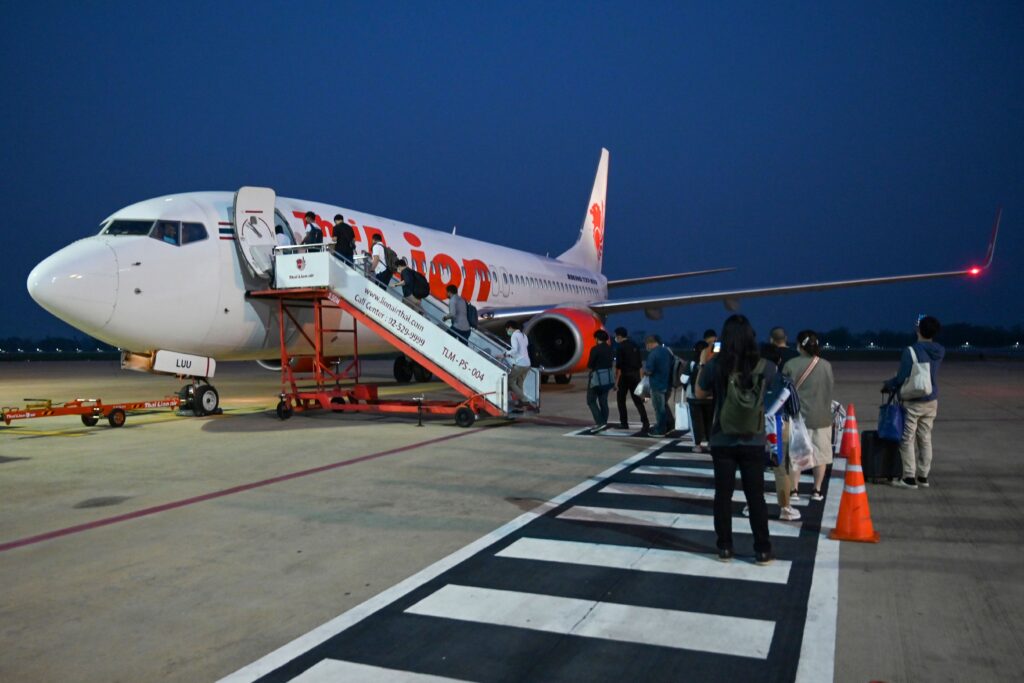How to tell the difference between planes (Tips for aspiring aviation geeks!)
Signing up for credit cards through partner links earns us a commission. Terms apply to the offers listed on this page. Here’s our full advertising policy: How we make money.
We fly so much that one day I decided to look around at the planes and check out the back of the in-flight magazine until I could tell the difference between them. The big planes were super easy — but I picked up some more tricks on telling the difference between them.
Here is a visual guide to telling the difference between planes. If you’re the reading type, I also wrote out the details below. Once you know these tricks, you too will be plane-spotting like a pro!
Airbus vs Boeing
Let’s talk about how to tell the difference between Boeing and Airbus. If we can find the differences between these companies, we can tell the difference between the planes.
Nose
Boeing’s noses have sharp points, and in general Airbus planes have more round noses. Although there are some exceptions to the Airbus noses, most planes have that look.
The double-decker planes showcase the nose differences most dramatically.
Boeing 747
Airbus 380
Although subtle, can you see the difference in how round the Airbus nose is?
Window
It’s hard to tell the difference between the windows of the cockpit, but if you’re close enough they are usually pretty distinct.
Airbus cockpit window:
Boeing cockpit window:
The Airbus window is more square, and the Boeing slants. The infographic points this out well.
Tail
Lastly, Boeing tails are slightly further back towards the end of the plane. The Airbus’ tails are generally more aligned with the fin tail that sticks up.
Boeing tail:
Airbus tail:
Comparing midsize long hauls
The last two times I flew across the Atlantic was on the Airbus 330 and Boeing 777-200. Although, now a lot of long-hauls are operated by the Boeing 787 Dreamliner.
Now when you’re at the airport it’s hard to tell if the lone plane you’re looking at is a giant plane, midsize or small. You think you would just be able to look at it and tell it’s a midsize… but I at least am not that good yet.
So the first thing I look for single decker planes is how many doors it has, still. If it has four doors, you know you’re talking about this bracket of airplanes:
- 777-200
- A330
- 787
- A340
- A321
Does that make sense? If it has five doors, it must be a 773. If it has three doors, it must be a smaller regional plane. But if it has four doors, how do you tell the difference?
H3: Airbus A330
So how do we know if we’re looking at the A330 or A321? Both have four doors!
The easy way to tell the difference in A330 and A321 is that the A330 has a pointy boeing-like nose, and the A321 doesn’t. So if you can see the windows, you can view the nose to see it’s sharp.
Also, the A330 is a lot bigger and taller, and therefore has double back wheels. Big planes double the wheels in the back to bear the load.Airbus A340
This plane has a sharp nose. It’s also got four engines, double engines on each wing. This is unique for its size. However, it’s a little less common than the other planes — but at least we have a distinguishing feature.
Boeing 777
This plane sports three pairs of wheels on each side, which is unique. Additionally, the plane’s tail comes to a sharp tip at the end of the fuselage, distinct from a more common rounded or cone tip.
Boeing 787
The 787 Dreamliner has a distinct nose as it’s flat on the bottom all the way to the point. Another thing is that the 787 not only doesn’t have square corner cockpit windows (like the Airbus would) — it’s pointy like a diamond. Just by looking at these two features in the front you can instantly know that this four-door Boeing is a 787.
Airbus A321
This plane has four doors (as you’d expect), but not a pointy nose like the A330. The A321 has one set of wheels. It’s smaller than the A330, so it doesn’t need as heavy-duty landing gear.
Comparing two-door planes for regional flights
These small two-door planes used for regional flights are near perfect examples for distinguishing between Boeing and Airbus.
Boeing 737
The 737 has a pointy nose, slanted cockpit corner windows, and a tail wing that sits further back.

Airbus A320 family (includes A319, and A318)
The A320 aircraft has a more rounded nose, and its tail isn’t as near to the Auxiliary Power Unit (that hole in the back of the plane).
Comparing double-decker planes
Double-decker planes are unmistakable and they’re huge. Unfortunately, these planes are severely close to extinction. The below aircraft are no longer manufactured, so once those currently in service become defunct, that may very well be the end!
Airbus A380
This is fully double-decker and it’s the biggest commercial plane. When you see the A380…you know. It’s huge, and really only used for very long-haul flights.
Boeing 747
The 747 was once more common than the A380 — though a lot of airlines have been retiring the majestic aircraft.
Only the front half of this plane is a double-decker and that makes it unique. It’s equally noticeable to the A380 when you see the horn. I’ve compared it to a hornbill we saw in Malaysia.

Bottom line
There are of course more planes but I wanted to go through the popular Boeing and Airbus planes that make up all of your mid to long-haul flights, and most of your regional and short flights. These are the ways that I learned to tell the difference between planes — and if you can keep it all straight, I imagine it will work for you as well.
Featured image by Skycolors/Shutterstock.
Editorial Note: We're the Million Mile Secrets team. And we're proud of our content, opinions and analysis, and of our reader's comments. These haven’t been reviewed, approved or endorsed by any of the airlines, hotels, or credit card issuers which we often write about. And that’s just how we like it! :)






Join the Discussion!